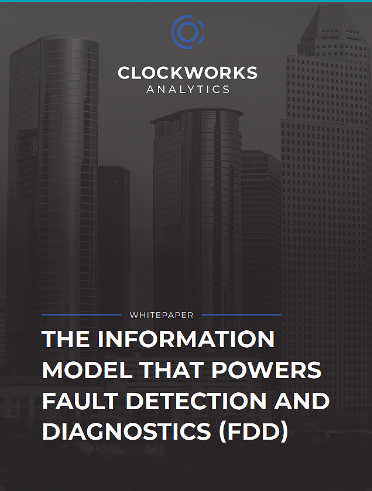Reduce Carbon Emissions Using Fault Detection and Diagnostics
September 4, 2024

Across life sciences organizations, facilities and operational leaders are tasked with developing and implementing strategies to reduce carbon emissions in the built environment. Over the past few years, carbon tracking has evolved from a secondary concern to a primary driver of business cases, impacting CEO KPIs, operational budgets, and sustainability teams. The challenge lies in cutting carbon footprints without resorting to expensive new equipment, which carries its own emissions.
At Clockworks Analytics, we understand the pressing need to reduce carbon emissions without hefty capital expenditures. Earlier this year, we hosted a webinar on this topic, led by our Managing Director, EMEA & APAC, Tyson Soutter, an industry veteran with international experience in developing smart building integrations and energy efficiency solutions.

Want to know how global life science organizations are addressing increasingly aggressive carbon neutrality regulations?
The Urgency of Carbon Reduction
Clockworks Analytics has been at the forefront of this movement since 2007, providing solutions that monitor and analyze building systems. For many innovative facilities leaders, the first step to reduce carbon within a single building or across a portfolio is implementing fault detection and diagnostics (FDD) software.
The integration of FDD with HVAC systems, digital twins, and data modeling can significantly reduce carbon emissions and energy costs. The key is to connect, model, and utilize existing telemetry data from control systems like Siemens, Honeywell, Johnson Controls, and Schneider Electric.
Comprehensive Building Systems Data Analysis
Effective carbon reduction requires robust data quality. Clockworks’ global analysis engine uses a blend of rule-based analysis, machine learning, and AI to process and standardize data across systems and locations. This comprehensive approach ensures even complex life sciences environments can achieve significant energy savings.
When leaders invest in FDD software, they aim to reduce carbon by improving energy efficiency and equipment performance. The most critical component is the system’s Information Model, which analyzes building data and produces diagnostics. Unfortunately, not all FDD tools progress beyond simple fault detection to true root-cause diagnostics.
The most critical component of Fault Detection and Diagnostic (FDD) software is its Information Model. This Information Model acts as the “brain” that analyzes building data and produces the diagnostics that help building owners derive energy savings, operational savings, and better performing equipment. But not all Information Models are equal.

Adapting Building Systems Data to Clockworks
Unlike many FDD tools, Clockworks is built to accept data as-is and provide insights. Our algorithms dynamically accept the best available information, avoiding false alarms, reducing setup effort, and providing a holistic view of your building portfolio. Our system understands equipment interdependencies to deliver comprehensive diagnostics.
Clockworks’ FDD software has scaled globally, monitoring over 435,000 pieces of equipment across 30+ countries. Our long-standing partnership with Amgen illustrates the tangible benefits. Facing ambitious carbon targets, Amgen transformed its energy management approach, deploying FDD in both office/lab and manufacturing facilities. Their FDD program’s success was then recognized with an industry award in 2017.

Want to learn more about Amgen’s ambitious, award-winning carbon reduction program? Read the Case Study.
Future-Proofing with Building Analytics
As carbon regulations and reporting requirements intensify, integrating building analytics becomes crucial. Clockworks’ solution helps clients not only meet compliance demands but also drive meaningful emissions reductions, all while maximizing the efficiency of existing building systems. Let’s work together to create a more sustainable future, one building at a time.

